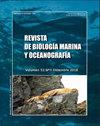Asociaciones macrobentónicas con presencia de mitílidos de la bahía San Julián (Patagonia austral, Argentina)
IF 0.5
4区 生物学
Q4 MARINE & FRESHWATER BIOLOGY
引用次数: 5
Abstract
espanolLas asociaciones de macrobentos con presencia de mitilidos de la bahia San Julian (Patagonia austral, Argentina) fueron muestreadas durante el verano de 2007 para conocer su estructura, diversidad y distribucion, y para determinar su relacion con diversos factores ambientales. El estudio fue realizado en 3 localidades con diferentes tipos de sustrato y distinta pendiente. El muestreo en cada localidad se realizo en una transecta abarcando diferentes niveles del intermareal y del submareal somero. Se hallaron un total de 46 especies pertenecientes principalmente a moluscos (20), crustaceos (12) y poliquetos (10). Se identificaron 3 asociaciones principales: la asociacion Platynereis-Clunio-Darina se distribuyo en el nivel intermareal superior de sustrato fangoso y pendientes suaves y presento los valores mas bajos de numero de especies, de diversidad especifica y de abundancia de individuos; la asociacion Mytilus-Perumytilus se distribuyo en los niveles intermareales medio e inferior en sustrato rocoso o en sustrato fangoso con abundantes elementos de soporte y pendiente media; presento diversidad especifica intermedia y la mayor abundancia de individuos; la asociacion Aulacomya-Exosphaeroma presento el mayor numero de especies y la mayor diversidad, pero baja abundancia de individuos, encontrandose relacionado a sustratos rocosos o sustratos fangosos con elementos de soporte y baja pendiente del submareal superior. La riqueza especifica y la diversidad de estas asociaciones aumentan desde el nivel superior del intermareal hacia el submareal, posiblemente por efecto de un gradiente complejo de estres, principalmente ocasionado por la desecacion y exposicion a temperaturas extremas. EnglishThe macrobenthic assemblages with mytilids of San Julian bay (Southern Patagonia, Argentina) were sampled in summer 2007 to know its structure, diversity and distribution, and to determine their relationship to different environmental factors. The study was conducted in 3 locations with different types of substrate and slope. Sampling at each site was performed in a transect to cover different levels of intertidal and shallow subtidal. A total of 46 species belonging mainly to molluscs (20), crustaceans (12) and polychaetes (10) were found. Three main macrofaunal assemblages were identified. Platynereis-Clunio-Darina assemblage was distributed in the upper intertidal of muddy and gentle slopes substrate, and had the lowest values of number of species, diversity and abundance of individuals. The Mytilus-Perumytilus assemblage was distributed in the middle and lower intertidal levels in rocky substrate or muddy substrate with abundant support elements and medium slope. This assemblage presented intermediate values of diversity and greater abundance of individuals. The Aulacomya-Exosphaeroma assemblage had the highest number of species and the greatest diversity, but low abundance of individuals, being related to rocky substrate or muddy substrate with support elements and low slopes in the upper subtidal. Species richness and diversity of these assemblages increases from the upper intertidal to subtidal, possibly because of a complex gradient of stress, mainly caused by desiccation and exposure to extreme temperatures.来自圣朱利安湾(阿根廷南巴塔哥尼亚)的大型浮游动物与有翅目动物的存在
在本研究中,我们分析了来自阿根廷巴塔哥尼亚圣Julian湾(南巴塔哥尼亚,阿根廷)的大型动物与贻贝的关系,以了解它们的结构、多样性和分布,并确定它们与各种环境因素的关系。本研究的目的是评估在不同基质类型和不同坡度的3个地点进行的研究。在每个地点的样带中取样,覆盖潮间带和浅潮下的不同水平。共发现46种,主要属于软体动物(20种)、甲壳类动物(12种)和多毛类动物(10种)。我们确定了3个主要的组合:Platynereis-Clunio-Darina组合分布在上潮间带泥滩和软坡,物种数量、物种多样性和丰度最低;Mytilus-Perumytilus组合分布在潮间带中下水平的岩石或泥质基质中,具有丰富的支撑元素和中等坡度;具有中等的物种多样性和最高的个体丰度;在本研究中,我们分析了两种不同物种之间的关系,一种是双壳类,另一种是双壳类。这些组合的物种丰富度和多样性从潮间带上层向潮下增加,可能是由于主要由干旱和极端温度引起的复杂压力梯度的影响。2007年夏天,对圣朱利安湾(阿根廷南巴塔哥尼亚)的贻贝进行了取样,以了解其结构、多样性和分布,并确定其与不同环境因素的关系。这项研究是在三个不同类型的基底和坡度的位置进行的。= =地理= =根据美国人口普查,该地区的总面积为,其中土地和(2.641平方公里)水。= =地理= =根据美国人口普查,该县的总面积为,其中土地和(3.064平方公里)水。= =地理= =根据美国人口普查,该县的总面积为,其中土地和(3.064平方公里)水。= =地理= =根据美国人口普查,这个县的总面积为,其中土地和(2.641平方公里)水。= =地理= =根据美国人口普查,该地区的总面积为,其中土地和(2.641平方公里)水。= =地理= =根据美国人口普查,这个县的总面积为,其中土地和(0.964平方公里)水。= =地理= =根据美国人口普查,这个县的总面积为,其中土地和(2.641平方公里)水。= =地理= =根据美国人口普查,这个县的总面积为,其中土地和(2.641平方公里)水。
本文章由计算机程序翻译,如有差异,请以英文原文为准。
求助全文
约1分钟内获得全文
求助全文
来源期刊
CiteScore
0.70
自引率
0.00%
发文量
41
审稿时长
12 months
期刊介绍:
Publicar desde una perspectiva científica, artículos originales, decididos por un proceso de revisión por pares, invitando a expertos de reconocido prestigio en el área. Los trabajos publicados se caracterizarán por su solidez teórica-metodológica, actualidad y relevancia para las ciencias marinas.
Se reciben trabajos inéditos derivados de la investigación científica realizada en ambientes marinos y estuarios, en formato de Revisión, Artículos, Notas Científicas, y Obituarios en las siguientes disciplinas::
Biología-Ecología marina
Oceanografía física, química y biológica
Contaminación marina
Geología marina
Sistemática, Faunística y Biogeografía Marina
Manejo Costero
Acuicultura marina
Pesquería marina.

 求助内容:
求助内容: 应助结果提醒方式:
应助结果提醒方式:


